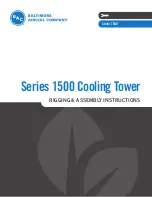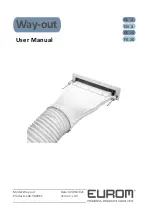
46
an effect depending on the installed elevation of the unit. If the
rooftop is installed at a particularly high altitude and enthalpy or
cfm are being calculated, set this configuration to the current ele-
vation of the installed rooftop.
Start Up Delay Time (DLAY)
This option inhibits the unit from operating after a power reset.
The configuration may be adjusted from 0 to 900 seconds of delay.
Auxiliary Relay Output Configuration (AUX.R)
This configuration allows the user to configure the function of the
auxiliary relay output. The output is 1.4 vac, 5 va maximum. The
configuration can be set from 0 to 3. If
AUX.R
is set to 0, the aux-
iliary relay contact will be energized during an alarm. The output
can be used to turn on an indicator light or sound an alarm in a me-
chanical room. If
AUX.R
is set to 1, the auxiliary relay will ener-
gize when the controls determine that dehumidification/reheat is
needed. The relay would be wired to a third party dehumidifica-
tion/reheat device and would energize the device when needed. If
AUX.R
is set to 2, the auxiliary relay will energize when the unit is
in the occupied state. The relay could then be used to control light-
ing or other functions that need to be on during the occupied state.
If
AUX.R
is set to 3, the auxiliary relay will energize when the
supply fan is energized (and, if equipped with a VFD, the VFD
output is not 0%). The default is 0.
Space Temp Sensor (SPT.S)
If a space temperature sensor is installed (T55/T56), enable
this configuration.
Space Temp Offset Sensor (SP.O.S)
If a T56 sensor is installed with the space temperature offset
slider, enable this configuration.
Space Temp Offset Range (SP.O.R)
If a space temperature offset sensor is installed, it is possible to
configure the range of the slider by adjusting this range
configuration.
Space Air RH Sensor (SRH.S)
If a space relative humidity sensor is installed, enable this
configuration.
Return RH Sensor (RRH.S)
If a return air relative humidity sensor is installed, enable this
configuration.
Filter Status Switch Enabled? (FLT.S)
If a filter status switch is installed, enable this configuration to
begin the monitoring of the filter status input (
Inputs
GEN.I
FLT.S
). See the Dirty Filter Switch section on 72 for
more details on installation and operation.
Cooling Control
The P Series
Comfort
Link controls offer two basic control ap-
proaches to mechanical cooling: multi-stage cooling (CV) and
multiple stages of cooling (VAV). In addition, the
Comfort
Link
controls offer the ability to run multiple stages of cooling for
either a space temperature sensor or thermostat by controlling
the unit to a low or high cool supply air set point. The control
type (
Configuration
UNIT
C.TYP
) determines the selec-
tion of the type of cooling control as well as the technique for
selecting a cooling mode. Unit staging tables are shown in
Appendix C.
NOTE: Whether a unit has a VFD or a supply fan installed for
static pressure control has no effect on configuration of the ma-
chine control type (
C.TYP
). No matter the control type, it is possi-
ble to run the unit in either CV or VAV mode, provided there are
enough stages to accommodate lower air volumes for VAV opera-
tion. Refer to the Static Pressure Control section on page 69 for in-
formation on how to set up the unit for the type of supply fan con-
trol desired.
SETTING UP THE SYSTEM
Machine Control Type (Configuration
UNIT
C.TYP)
The most fundamental cooling control configuration is located
under
Configuration
UNIT
.
*This default is model number dependent.
This configuration defines the technique and control source re-
sponsible for selecting a cooling mode and in determining the
method by which compressors are staged. The control types are:
•
C.TYP
= 1 (VAV-RAT) and
C.TYP
= 2 (VAV-SPT)
Both of these configurations refer to standard VAV operation.
If the control is occupied, the supply fan is run continuously
and return-air temperature will be used for both in the deter-
mination of the selection of a cooling mode. VAV-SPT differs
from VAV-RAT only in that during the unoccupied period,
space temperature will be used instead of return-air tempera-
ture to start the fan for ten minutes before the return-air tem-
perature is allowed to call out any mode.
•
C.TYP
= 3 (TSTAT – MULTI)
This configuration will force the control to monitor the
thermostat inputs to make a determination of mode. Unlike
a traditional 2-stage thermostat control, the unit is allowed
to use multiple stages of cooling control and perform VAV
style operation. The control will be able to call out a LOW
COOL or a HIGH COOL mode and maintain a low or high
cool supply air set point.
•
C.TYP
= 4
(SPT – MULTI)
This configuration will force the control to monitor a space
temperature sensor to make a determination of mode. Un-
like a traditional 2-stage space temperature control, the
unit is allowed to use multiple stages of cooling control
and perform VAV style operation. The control will be able
to call out a LOW COOL or a HIGH COOL mode and
maintain a low or high cool supply air set point.
MACHINE DEPENDENT CONFIGURATIONS
Some configurations are linked to the physical unit and must
not be changed. The configurations are provided in case the
field replacement of a board occurs and the settings are not pre-
served by the download process of the new software. The fol-
lowing configurations apply to all machine control types
(
C.TYP
). These configurations are located at the local display
under
Configuration
UNIT
.
See Table 32.
Table 32 — Machine Dependent Configurations
*Dependent on unit.
Unit Size (SIZE)
There are 10 unit sizes (tons) for the P Series control. Make
sure this configuration matches the size called out by the model
number of the unit. This is important as the cooling stage tables
are determined directly based on the
SIZE
configuration.
50 Hertz Unit? (50.HZ)
This configuration is not used.
SET POINTS
The set points for both cooling and heating are located at the
local display under
Setpoints
.
See Table 33.
ITEM
EXPANSION
RANGE
CCN
POINT
DEFAULTS
UNIT
UNIT CONFIGURATION
C.TYP
Machine Control Type
1 - 4
CTRLTYPE
*
ITEM
EXPANSION
RANGE
CCN
POINT
DEFAULTS
UNIT
UNIT CONFIGURATION
SIZE
Unit Size (30-100)
30 - 100 UNITSIZE
*
Summary of Contents for Weathermaster 48P2030-100
Page 130: ...130 Fig 19 Typical Power Schematic Sizes 040 075 Shown ...
Page 131: ...131 Fig 20 Main Base Board Input Output Connections ...
Page 132: ...132 Fig 21 RXB EXB CEM SCB Input Output Connections ...
Page 133: ...133 Fig 22 Typical Gas Heat Unit Control Wiring 48P030 100 Units Shown ...
Page 134: ...134 Fig 23 Typical Electric Heat Wiring 50P030 100 Units Shown ...
Page 135: ...135 Fig 24 Typical Power Wiring 115 V ...
Page 136: ...136 Fig 25 Typical Gas Heat Section Size 030 050 Units Shown ...
Page 138: ...138 Fig 27 Component Arrangement Size 030 035 Units ...
Page 139: ...139 Fig 28 Component Arrangement Size 040 075 Units ...
Page 140: ...140 Fig 29 Component Arrangement Size 090 100 Units ...
















































